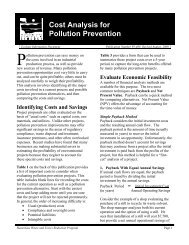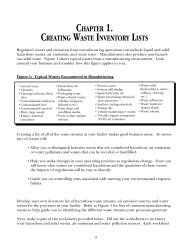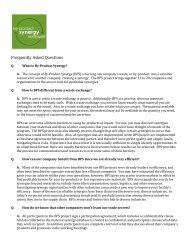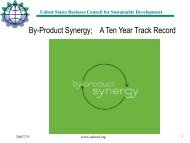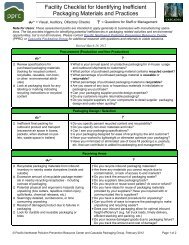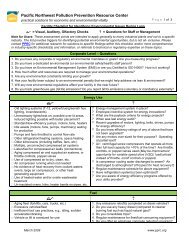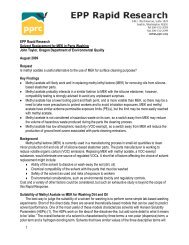Laboratory Spill Procedures Handout
Laboratory Spill Procedures Handout
Laboratory Spill Procedures Handout
You also want an ePaper? Increase the reach of your titles
YUMPU automatically turns print PDFs into web optimized ePapers that Google loves.
(Biohazardous <strong>Spill</strong>s continued)<br />
• Flood the top work surface tray and, if it is a Class II biological safety cabinet, the drain<br />
pans and catch basins below the work surface with the decontaminant and allow to stand<br />
for 10-15 minutes. The contact time should be extended to 30 minutes for large spills or<br />
spills containing large amounts of proteinaceous material;<br />
Remove excess decontaminant from the tray by wiping with a sponge or cloth soaked in<br />
decontaminant. For Class II biological safety cabinets, drain the tray into the catch basin<br />
below the work surface, lift out the tray and removable front intake grille, and wipe off<br />
top and bottom (underside) surfaces with a sponge or cloth soaked in a decontaminant.<br />
Replace the grille and drain decontaminant from the cabinet base into an appropriate<br />
container and autoclave according to standard procedures. Be sure to place gloves, cloth,<br />
and/or sponge into an autoclave pan to be autoclaved.<br />
*<strong>Spill</strong>s Outside the <strong>Laboratory</strong> (During Transport)<br />
If a biohazardous agent is spilled during transport outside the laboratory, the main difference<br />
from the first procedure is to initiate the cleanup immediately. Otherwise, use those procedures.<br />
Because it would already be too late to prevent aerosolization in this case, it is better to place<br />
extra emphasis on prevention of spills during transport:<br />
• Develop a procedure for the removal of biohazardous materials for incubation,<br />
refrigeration, or for any other reason from the laboratory, and enforce adherence to it;<br />
• Place all such materials in an unbreakable container that would prevent the escape of<br />
liquid or aerosol if it were dropped. One-gallon or half-gallon paint pails are good<br />
examples of acceptable containers;<br />
• Label the container with the biohazard symbol to ensure no mistake is made as to the<br />
contents.<br />
*Information taken from "<strong>Laboratory</strong> Safety, Principals and Practices, Second Edition",<br />
Chapter 14, "Decontamination, Sterilization, Disinfection, and Antisepsis" by Donald Vesley<br />
and James L. Lauer.<br />
Biohazard <strong>Spill</strong> Kit<br />
A well designed spill kit is highly recommended. It can save injury, time, and resources. The<br />
following items would be excellent choices for a Biohazard <strong>Spill</strong> Kit:<br />
• An appropriate chemical decontaminant -- in most cases a 10% household bleach<br />
solution is a good choice, but keep in mind that bleach will corrode stainless steel if left<br />
in contact with it for 30 minutes or more. For human blood and body fluids, iodophors or<br />
70% alcohol is appropriate;<br />
• Materials to absorb liquids after decontamination -- this could include paper towels,<br />
absorbent lab pads, or special materials designed to absorb large volumes of liquid. Keep<br />
in mind the volumes of liquid typically used in the laboratory area when selecting an<br />
absorbent;<br />
• Appropriate personal protective equipment to wear during clean-up -- gloves and a<br />
long-sleeved laboratory coat or gown are always necessary. Facial protection should be<br />
considered for large spills as well as protection against splash and splatter of the chemical<br />
decontaminant. Additional personal protective equipment is necessary when working<br />
with Class 3 agents.<br />
5



